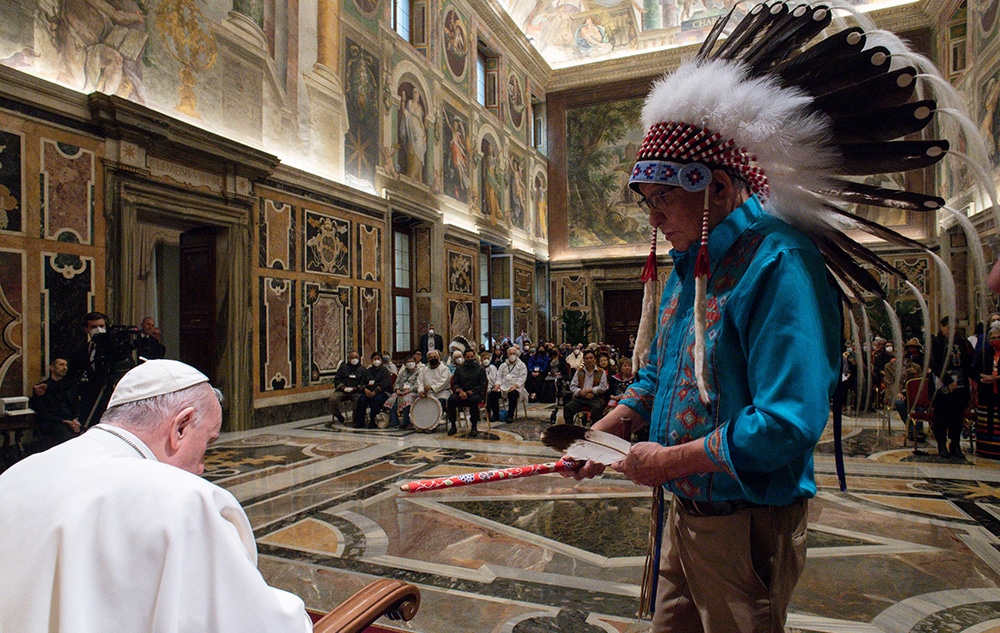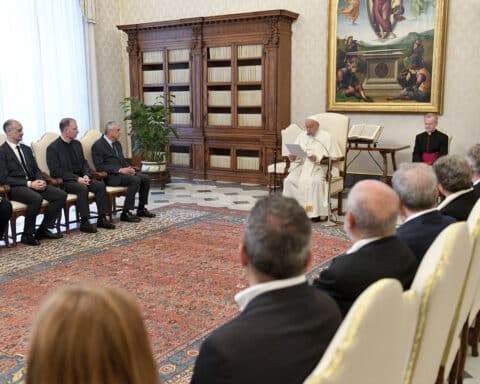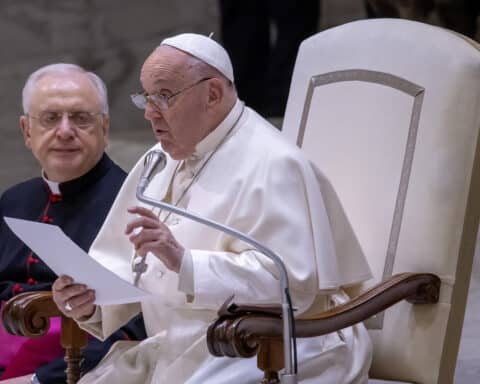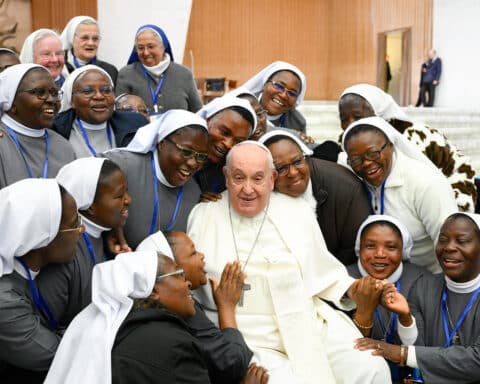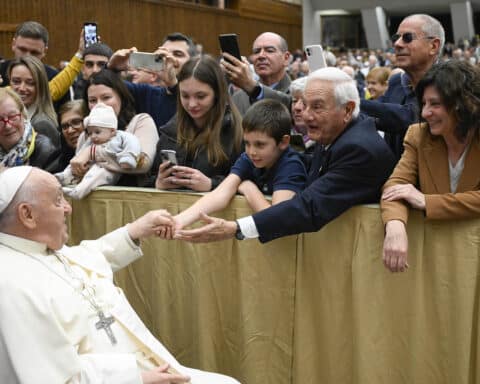“I am very sorry.”
With these four words, Pope Francis might have changed the course of history.
He shared them with a Canadian delegation of 170 First Nations, Inuit and Métis representatives who had come to Rome to describe the ghastly abuses of Indigenous children that were perpetrated in Canada’s residential schools.
The main purpose of these schools was to erase the culture of Aboriginal children, who were forced to attend and live at these schools whether their parents consented or not. As if this were not already repulsive enough, students at many of these schools were mistreated, belittled, physically harmed and sexually abused. Shamefully, the majority of these schools, as the 2015 Truth and Reconciliation Commission (TRC) reminded us, were run by Catholic clergy and religious.
The delegation consisted of Indigenous elders, knowledge keepers and residential school survivors. One of these was Phil Fontaine, an Ojibwe survivor who first brought this issue to national attention in the 1990s (at which point a few residential schools were still operating). He previously met with Pope Benedict about this issue in 2009. At that time, the pope privately expressed “sorrow” to Fontaine about the abuses but did not offer a public apology.
Another delegate was fellow survivor Wilton Littlechild, a Cree chief and TRC commissioner. It was the TRC that had called for the pope to apologize for these schools on Canadian soil, so Littlechild’s presence was significant.
Pope Francis spent a week meeting with the delegates. He also viewed presentations of Indigenous culture, including sacred drumming, dancing and fiddling. Rather than being driven out of the Church, like the residential schools attempted to do, Indigenous traditions were brought into the heart of Catholicism, where everything truly beautiful and spiritual should find a home.
On April 1, the pope stood before the representatives and made a public act of contrition. He confessed that he felt a mixture of indignation and shame, and stated clearly, “For the deplorable conduct of those members of the Catholic Church, I ask for God’s forgiveness, and I want to say to you with all my heart: I am very sorry.”
Everyone present for this meeting recounted that the pope’s grief and empathy were palpable. Both Littlechild and Fontaine remarked afterwards that they were moved by a particular detail: The Holy Father had not just said he was sorry, but that he was very sorry. That simple adjective touched them. They felt his sincerity and were blessed by it.
The Canadian Conference of Catholic Bishops, whose previous members obviously had far more complicity in this program of cultural genocide than the pope did, issued an apology back in September 2021. But there is an obvious reason why the pope’s apology will probably have more impact. We are embodied beings, which is why grace comes through sacraments. We do not just need spiritual healing and nourishment. We also need tangible symbols — the taste of the host, the touch of holy water on our fingertips and forehead, the visible pain on the face of the pope, the audible pain in his voice as he apologized. No matter how powerfully phrased it is, no formal apology from a conference will ever have the same power as a personal apology, even one on behalf of a whole community.
Of course, the Truth and Reconciliation Commission requested that the pope apologize on Canadian soil. During his address, he gave a clue when that might take place, referring to the “joy” he takes in “the great veneration that many of you have for St. Anne, the grandmother of Jesus. This year I would like to be with you on those days.”
The Aboriginal devotion to St. Anne that he refers to is remarkable, given that an especially notorious residential school shamefully bore her name, but it is also unsurprising. Indigenous communities respect their elders and long to receive wisdom from them (which is another reason the residential schools were so egregiously vile: They wanted to rob the First Peoples of the legacy of their grandparents). It is no wonder they would honor Jesus’ grandmother, whom we can easily imagine as an elder to the Holy Family
Moreover, Lac Ste. Anne in Alberta, which is called “God’s Lake” by the Cree and Alexis Nakota Sioux people, is a popular pilgrimage site for Indigenous Catholics, many of whom have Lourdes-esque stories of miraculous healings of those who have touched its waters. This pilgrimage usually occurs on St. Anne’s feast day, July 26. Is that when Pope Francis will visit? Is that — my Albertan heart soars at the prospect — where he will visit?
Whenever, and wherever, he comes, we can hope that he will continue accomplishing the important work of reconciliation. In January of this year, the Canadian bishops committed to raising $30 million toward “addressing the historical and ongoing trauma caused by the residential school system.” They established a charity for this purpose, the board of which includes Chief Littlechild as a member. Hopefully, it can reach this amount by July. If not, perhaps the pope’s visit will help them achieve that goal.
There was one other effect of this papal apology that has gone underreported. The purpose of reconciliation is peace, and peace brings with it stability and clarity. These have not been features of Canadian discourse lately, especially when it comes to this issue.
For example, consider the infamously shocking story of 215 unmarked Indigenous children’s graves. Some found this news so infuriating that they not only vandalized churches but, in some cases, burned them to the ground (including houses of worship for communities that had nothing to do with the residential schools, like the Coptic Orthodox). Although First Nations leaders condemned these crimes, Canada’s superficially Catholic Prime Minister did not utter a single word of disapproval about them. Needless to say, in the process of attacking other people’s spiritual traditions, these arsonists did not actually help a single Indigenous person.
Several months later, the conservative-leaning journal the Dorchester Review put forward evidence that the figures in these reports may not be accurate. The anthropologist who made the discovery has admitted that her ground-penetrating radar might have mistaken “tree roots, metal and stones” for human remains. We can’t know whether or not her estimate of over 200 bodies is correct without excavations, but, so far, there have not been any. It’s therefore possible that these numbers are grossly inflated.
This, in turn, has provoked an equally furious response from those who feel that false information was uncritically published and used as an excuse to attack the Church. Some ill-tempered commentators have even called the idea of unmarked residential school graves a “hoax.” This is blatantly untrue: We have known for many years that such graves do exist, whether or not these particular radar signatures happen to be dead bodies or just debris.
The result of all of this has been an ugly mess. Legitimate anger over the loss of Indigenous children has been twisted into a vile and vengeful hatred of Christ’s Church. Meanwhile, legitimate concerns about accuracy and even a well-meaning piety have contorted into a cruel denialism of the harm that callous school workers and a ruthless system caused to innocent children and oppressed communities. This has made discussing this issue usefully almost impossible, and has muddled the important work of reconciliation into a mire of wrathful confusion.
But, while the devil might be the author of confusion, God is the author of clarity and of peace (cf. 1 Cor 14:33). With the plain and direct expression, “I’m very sorry,” Pope Francis may have gone a long way toward clearing away this mess so that there can be healing instead.
Archbishop Richard Smith of Edmonton reports that, after the apology, some male elders approached the bishops with a simple message: “We are now brothers.” Perhaps, in that moment, though everyone had tears in their eyes, everything seemed clear.
St. Anne, pray that, when the pope comes to Canada, God will make mercy, justice and love clear to us all.
Brett Fawcett writes from Canada.

